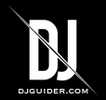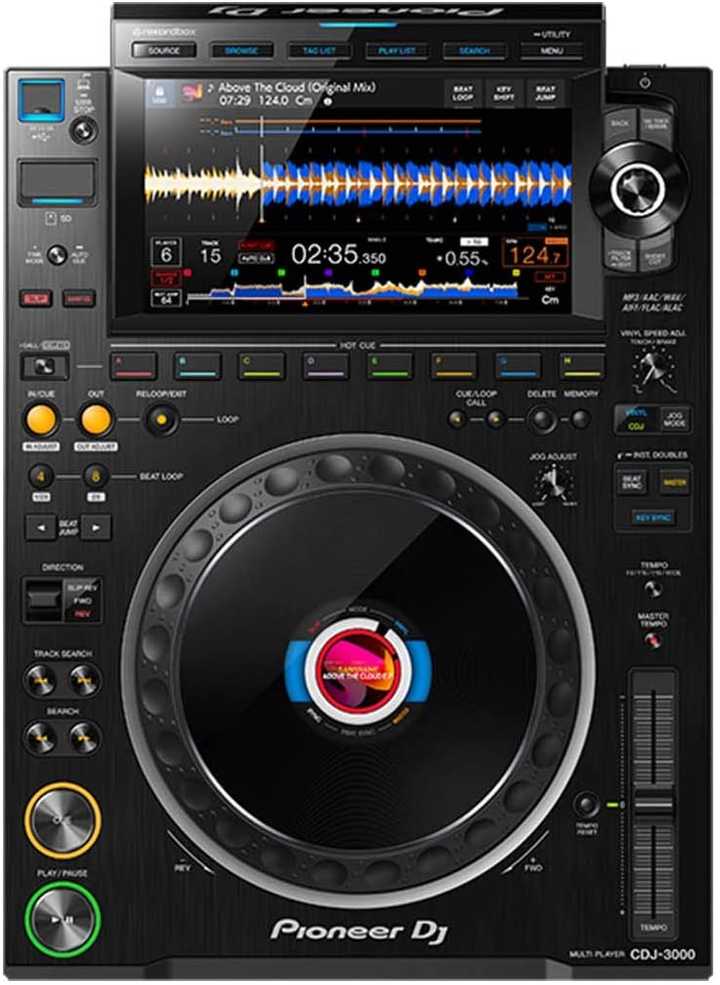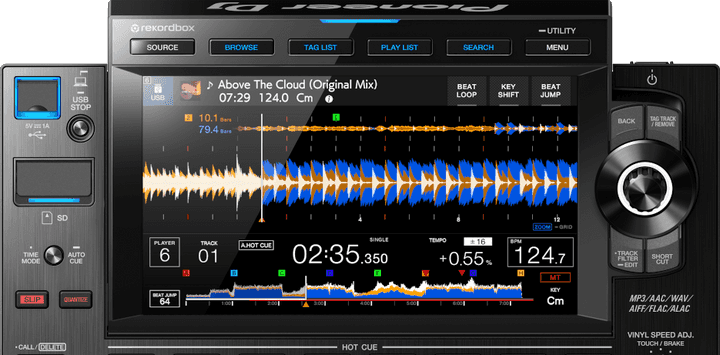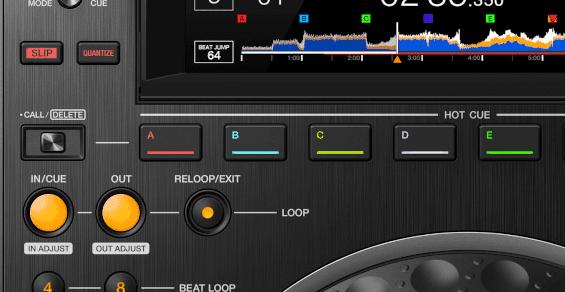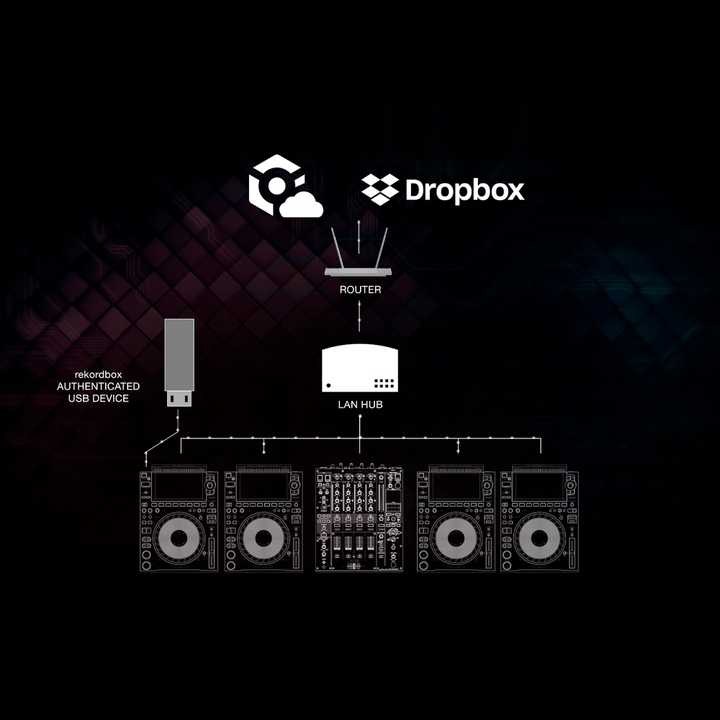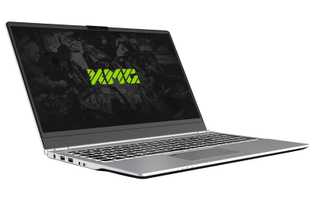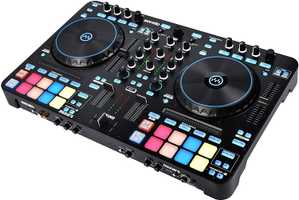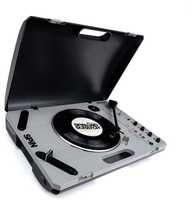Pioneer DJ CDJ-3000 professional DJ multiplayer Review
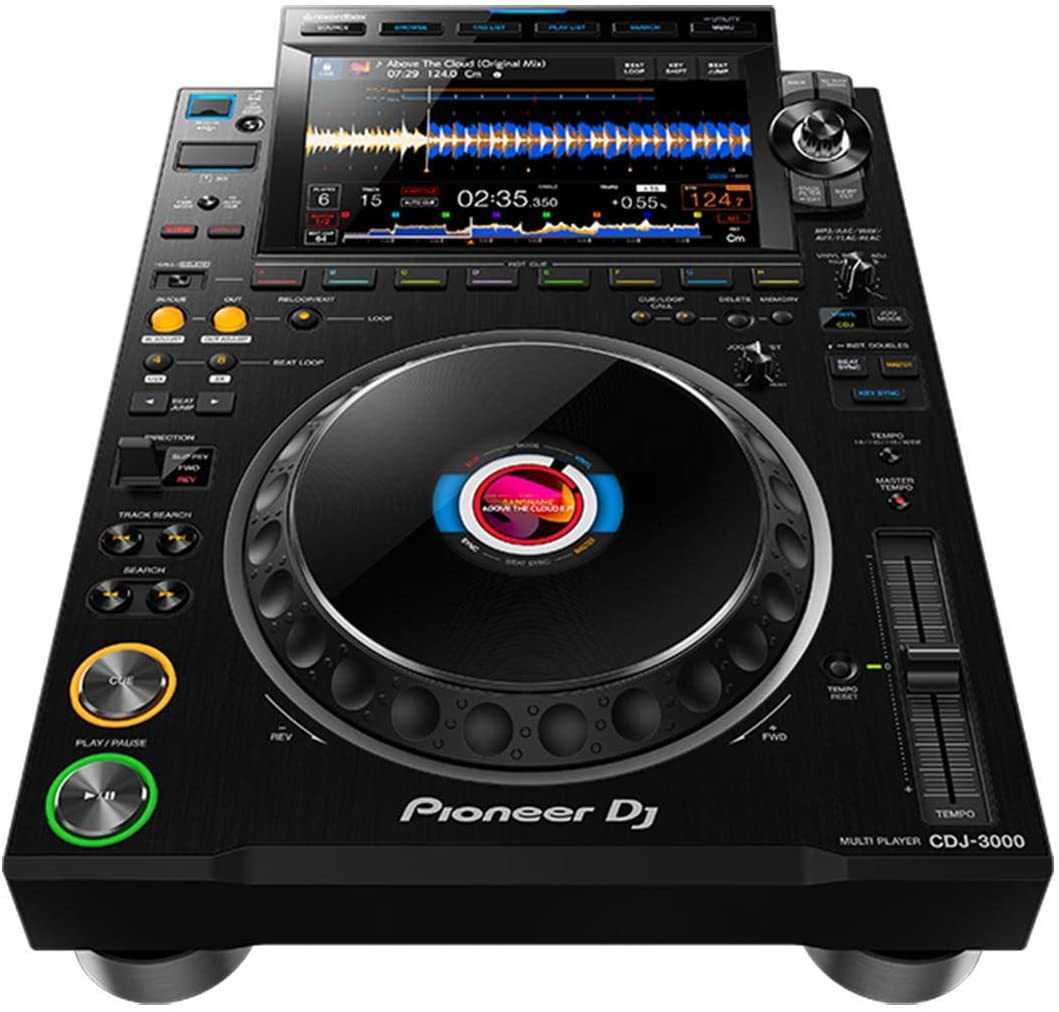
Today I’m doing a detailed review of the CDJ 3000, the new professional DJ multiplayer. I’m excited to show you guys this one because it’s the first CDJ release that has happened.
I got to see firsthand the hard work it takes from the engineers to the product planning and all the research to put together a multiplayer.
- Number of Decks:1
- Display:9″ HD LCD Touchscreen
- Compatible Media: USB flash, SD Card, iPhone
- Compatible Files:WAV, AIFF, MP3, AAC, Rekordbox
- Jog Wheels:1 x 8″ Jog Wheel
- Pads:8 x Hot Cue Buttons
- Analog Outputs:1 x Dual RCA Stereo
- Digital Outputs:1 x Coaxial (S/PDIF)
- USB:1 x Type A, 1 x Type B
- Other I/O :1 x Ethernet LAN (ProDJ Link)
- Compatibility:Rekordbox
Power Supply: Standard IEC AC cable
- Height:4.65″
- Width:12.95″
- Depth:17.83″
- Weight:12.1 lbs
Processor
The CDJ 3000 was designed to enhance the experience of the current users of the CDJ 2000 nexus 2. It all starts with the heart of the unit which is the MPU the microprocessing unit.
It’s the most powerful MPU on any DJ multiplayer in the market. It has a total of six cores divided into two groups. Is a 1.5 gigahertz dual-core arm cortex a57. The other is a 1.2 gigahertz quad-core arm cortex a53.
Not only does it improve the speed and performance of the player it gives us a pioneer the ability to upgrade features on the player as years come. That means there are going to be new features that are going to be rolled out without the need for you to buy a new player.
Build Quality
The build quality is improved from the 2000 nexus 2 it’s designed so that you can operate it and up to 150 degrees Fahrenheit. I’m sure that’s way above anyone’s comfort zone to be playing outside. More importantly, it’s designed to be able to take the environment that laptops would overheat in.
The design is a little bit more desert-proof, we’re going to talk about the jog wheel more later, but it is particle and dust-resistant. The cooling system is also designed to make sure that dust particles don’t get inside the components.
It has a full metal faceplate throughout the entire top. when you first touch it you will notice that all the knobs and sliders and even the paddle feel a lot tighter. They don’t move around as much. If you were wondering what the teaser video is all about: the cue and play buttons are made to be able to withstand up to a million clicks. so that means I can do my cue button scratch all day.
Built for the Pro DJ
This was built specifically for the pro DJs. A lot of the design decisions were based on the research of 200 major artists. The player is targeted specifically at the users who perform at clubs and festival stages. The design language is about the simplicity of use and setup.
Dedicated buttons mean one button equals one function, and one deck equals one channel. Cdjs on the festival stage are often used in four and these are made to be able to use in six if you have a 6 channel mixer.
The pro DJs don’t want to risk any confusion about the function of a button or an entire deck. When you got multiple decks laid out you don’t want to forget that you might have had a performance pad set to roll loop when you’re meant to click a hotkey.
Dedicated buttons that are one button for one function eliminate that risk. Also, it keeps the setup simple and less confusing for the stage crew. It has to be simple enough that even the least knowledgeable stage crew person can simply just hook it up and it’s ready to go.
Instead of trying to manage multiple riders with multiple configurations with just two decks. The folks who play on four decks want to be seen with four decks.
NEW Display
Let’s talk about the brand-new 9-inch display. It is HD 720p and the refresh rate is 60 frames per second. It’s a lot smoother than it was before. It’s a really efficient use of the entire nine-inch space of the display.
Sometimes a display can be bigger but the effect of use is a lot smaller than the size of the entire display.
It’s also a pressure-sensitive touch display. The reason for this is because that way we can have it pressure-sensitive, so there’s no accidental triggering of any of the functions.
Also not having it as a multi-touch reduces the risk of accidental triggering when there is moisture on your hands.
Have you ever tried to use your phones when your hands are clammy or if they’re wet, and you notice that sometimes it’s either not responding or it’s responding incorrectly?
DJs are going to be playing in environments where they’re most likely going to sweat. I hope they do. This keeps it from having those issues known with multi-touch displays.
Unlike before you can now load the songs or click the songs with the touchscreen. You can also touch the scroll including flicking the playlist.
Speaking of the playlist if you notice it’s made to look more like how it looks inside Rekordbox. You got your preview waveform, your track your bpm, and your key. You can always pull up the info on the upper right.
The display is super bright and it’s made to be brighter than the CDJ 2000 nexus 2. I have it set to 3 but we can take the LCD all the way up to 5. The jog LCD brightness is independent of the main display. Also, you can adjust the brightness of the led ring in case it’s too bright at a dark nightclub.
I can access my playlist by this new playlist button which you have to access by going to browse and then selecting a playlist. Now it’s a shortcut button that just takes you straight there.
For the source, it used to be that there were dedicated source buttons now it’s a single source button that opens up a menu where you can select your source. We got our hid mode or we have our export mode, depending on what you have connected.
NEW Waveforms
Let’s talk about waveforms. You can set it to RGB. I’m going to go into my shortcut menu and I can switch it to the blue waveforms, or I can switch it to the three-band waveforms that were introduced in Rekordbox six.
The 3 band waveforms have a separate waveform that you can see base mid and treble.
So there’s a total of three waveform types that you can use. I generally like to keep it at RGB. what’s also cool with the nine-inch touchscreen it gives us space to be able to stack the waveforms.
Let’s say I have a song playing and it is set to master, I can see this waveform on the top of this when it’s playing.
So now I can do waveform matching or grid matching depending on what I’m using. Also now we have the transients that we can visually see to match. What we’ll always show on the top is the player that’s set to master.
NEW Harmonic Key FEATURES
There are brand-new harmonic key features that are built into the player. You are now able to change the key of a track per every semitone and also shows you the Camelot code.
The key shift is an advanced one that helps prevent a little bit of chipmunking or Darth Vader which means it’s trying to preserve as much of the format as possible.
If you go extreme like five semitones up you’re gonna hear a little bit of it, but it tries to prevent it as much as possible by replacing the upper harmonics and putting them down below or taking the lower harmonics and filling them up high very similar to how complex pro works in Ableton Live.
That way when you’re doing key shifting it doesn’t sound like your key shifting.
Why do we have key shifting?
This way if you’re one of the folks who like to mix in key, I do, you can now change the key of tracks similar to how we can already do in Rekordbox and match it with the song you’re playing.
In addition to being able to shift the key manually, there is a key sync button, that will do the key matching for you. If the track is in f minor and the other one is an f sharp minor by clicking key sync it’s going to lower this track to match them.
NEW Gigabit Ethernet Connectivity
Next, we’re going to talk about the gigabit ethernet connectivity when you’re using the Pro DJ Link. Basically, CDJs have always been able to interlink with each other including with a DJ mixer that is capable of pro DJ link.
One of the questions folks ask is:
Why isn’t their wi-fi on these players?
When you think about it wi-fi itself is not a reliable platform. You have to think from a pro DJ standpoint on a festival stage they’re not going to be trying to get on wi-fi trying to access to get their music. They’re usually just going gonna bring one of these CDJ-3000.
It’s simple and it’s not prone to any of the problems with wi-fi as far as interference or reliability. With thousands of people in the crowd, all most likely gonna have a smartphone on them. You can never predict how wireless interference is going to play in a setup.
Tiesto and Skrillex aren’t going to be trying to access their Title or their Beatport link during a performance. So rather it was prioritized to improve the speed and stability of the connectivity of the players, especially since the CDJ 3000 is now capable of being used six at a time. That’s why gigabit ethernet was implemented instead.
Why USB 2.0
Speaking of stability this is also why the USB ports are USB 2.0. USB 2.0 is more than adequate enough for high-speed data transfer of music files. There wasn’t really a performance gain with USB 3.0 but there was a penalty with stability.
This isn’t just on CDJs if you’ve ever used a USB 3.0 hard drive and you used it on a USB 3.0 hub. Sometimes you might notice it gets disconnected.
I notice this all the time when I’m using multiple USB 3.0 devices on one USB 3.0 hub. The same devices being used on a USB 2.0 hub never seems to have the same problem.
This doesn’t mean you can’t use a USB 3.0 or 3.1 flash drive, which I use. It just means that your connectivity to the player is going to be USB 2.0.
Why would someone use a USB 3.0 hub if that’s a 2.0 port?
Well on your laptop or computer that you’re exporting to it just increases the speed of exporting to the flash drive. but once you put on the player it resets 2.0 it’s stable and it’s still fast.
TWO dedicated Auto-Loop buttons
There’s a small change to the loop functions before on the CDJ 2000 nexus 2. There was a button where you can initiate a four-beat loop. If you hold it down it can be an eight-beat loop. There is a dedicated 4-beat loop button and an 8-beat loop button.
What’s cool with the loop buttons is as soon as you press the button the beat loop functions show up and you can immediately change the loop length up to 32 beats.
If you initially wanted to do something longer you could just start with the eight-beat loop and then just increase it to 32 beats immediately.
The loop buttons, the reason why there are two is that if you click 4 (four-beat loop) and you wanna tighten it immediately you can click it, and then if you press it’s gonna cut in half to a 2-beat loop. If you press it again it’s gonna cut in half to 1 beat loop then a half-beat loop.
If you do an 8-bit loop if you press going up it doubles it. You can use these buttons once a loop is engaged to control the loop length.
NEW dedicated Beat Jump buttons
Brand new to the player there are now dedicated beat jump buttons, instead of being on the touchscreen like they were before. This allows you to skip one beat ahead of the song or prior to the song.
So if you’re trying to lengthen or shorten a phrase you can use the beat jump buttons to skip ahead or go backward on a track.
By default, it’s set to 16 beats which I would say is about half or maybe a quarter of a full house music intro. You can actually change the beat jump link by going into:
- going into the utility,
- going into DJ settings
- go to beat jump value
- and you could lower this or raise this from half a beat all the way to 64 beats.
- I kind of like mine at 8 beats, instead of 16.
Consolidated Touch/Release knob
If you notice there is only one knob for the vinyl speed adjustment. By default, it’s only controlling the break. So you have an instant start but you have a wind-down turntable-style break.
I know some people do like the wind-up start but we removed that because a lot of people sometimes accidentally move it and don’t mean to use it, and just prefer the advantage of a digital player being able to do an instant start.
If you really really want the wind up to start the slow start, you can:
- go into the menu
- back at DJ settings
- you can go vinyl speed adjust
by default, it’s set to touch if you set it to release it’s only going to control the wind-up during a start but it’s going to instantly stop.
If you want it to be controlling both you can set it to touch start and now the one knob controls both the startup time and the breaking time. The setting of touch and release is basically the default that you would find on the single knob on the cdj900 nexus or the CDJ-1000 mark ii.
I’m just going to keep it back to touch since I never have a reason for using a slow release.
NEW dedicated 8 RGB Hot Cue buttons
Let’s talk about the hot cues that are located underneath the screen. There are now 8 dedicated buttons for the hot cues. Before on the CDJ 2000 nexus 2, there were 4 buttons, with a bank button. So you can either access the first floor or the second floor. Now there’s no more flipping of the banks.
The reason for this position is because upon research this was the more preferred position because if you have them down you have more of a risk of folks accidentally touching them when they’re manipulating the jog wheel. Some folks like to actually rest their hand over.
Now in a two-deck setup that might not be the case, especially on a controller, that’s why controllers have them up. But you got to think if you’re using them in 4 or 6 decks you’re a lot wider from the reach of the outer CDJs, so you increase the risk of accidentally touching them down below.
Also for folks who are turntablist with the CDJs and like to scratch having performance pads or hot cues down below, prevents you from doing a couple of body tricks because you might accidentally touch those in those circumstances as well.
So it was decided that it was best to be below the display and above the jog wheel.
Also, you got to think a lot of CDJ users have been using CDJs for many years maybe even as far back as the CDJ-1000s. These were the first players to feature hot cues. When you look at the positioning of the hot cues they were always on the upper left corner and that has been pretty much the same all the way to the 2000 nexus 2.
By having them over it’s not a huge jump from the comfort zone of legacy DJs playing on the previous gear. Especially for those DJs that are going back and forth between the 2000 nexus 2 and getting on a 3000, it’s not a huge change from where they’re used to.
Some folks brought up what about accidentally touching the dog wheel with your wrist palm forearm or elbow.
Well, you would have to be a little bit praying mantis style. It’s made so that if you are going to be performing with the hot cues there’s enough clearance that you kind of go around it when you’re using it.
If you’re really concerned about accidentally touching the jog wheel you can always switch the jog wheel to CDJ mode. If you accidentally touch the jungle you could literally be typing on the hot cues with no problem.
Just to compare the two risks of having it down below and above, accidentally hitting the hot cues is a lot more devastating than accidentally touching the jog wheel. Touching the dog wheel it corrects itself once you let go.
Accidentally hitting the hot cue throws you in a position of the song where you might not want to be. Once again if you’re using multiple CDJs and they’re a lot farther out you have a lot more clearance from the jog wheel than you do hovering over hot cues that are down below.
REDESIGNED Jog Wheel
We mentioned the jog wheel, so let’s talk about the jog wheel. As I talked about earlier this may not be obvious with how it looks but the jog wheel has been redesigned. I’m not just talking about the new LCD display and rotation indicator that can show your album artwork in the middle
What some folks don’t know is that the mechanism of the jog wheel hasn’t been redesigned since the CDJ-800. The cdj800 had a bearing mechanism and that’s basically been the same mechanism that’s been used all the way to the 2000 nexus 2.
The only other full-size pressure-sensitive jog wheel, say that is three times as fast as the previous CDJ-1000, which came before the CDj-800.
This one had a really high friction jog on it. In a lot of photos, it looks the same it has the same design ridges on the outside same led ring from the 2000 nexus 2, and all the flagships.
The only visible difference is the LCD that was inspired by the CDJ-1000. Inside it is no longer the bearing mechanism and it was redesigned.
It was risky redesigning it because the bearing mechanism was a staple for many years for the flagship model that was industry standard. It’s one of the hardest things for competitors to imitate because one of the hard parts of a stationary non-moving jog wheel is just the balancing of the weight.
That’s why maybe for some players it’s harder to scratch on because it’s just not the same as what it was on the CDJs.
This new one is made to be smoother quieter and resistant to dust particles sand-like I mentioned earlier. In fact, there’s a lot more to give when you put the tension control down. It really spins. I like to set mine at two o’clock. Huge difference.
It’s one of those things that like on the product photos or even the videos doesn’t really jump out at you. But you will notice this right away when you play on this player especially if you’re used to a 2000 nexus 2. It feels different.
The surface of the jog wheel has these grooves some people have even described it to be more vinyl-like. I won’t even say that it’s vinyl-like but it increases your grip.
I know when I do my boomerang scratches I don’t tend to slip out as I do on the other players. Usually, my hand tends to move outward but it doesn’t do it here, it tends to stay put. These grooves keep your hand better gripped to the player.
So my benchmark on any player, not just the pioneer stuff but my benchmark for accepting a jog wheel is if I can do the peter piper routine using that jog wheel.
There are Jog Wheels out there that I have difficulty with but generally, if I can do the peter piper routine on it that’s when I’m cool with it.
I love how this feels because it doesn’t feel to be as restrictive as the previous jog wheels where I really have to press. Especially when I’m used to the touch-sensitive jog wheels the capacitive jog wheels on the controllers, where I’d learn to have a light touch so I really like how this one is.
Another thing I like to do is I like to turn the jog adjust up and now I haven’t been able to do this on the previous CDJs but I can do a little bit of drum scratching.
That’s something that I wasn’t able to do on previous players at least not that well controlled.
HID mode DJ software support
What about hid mode? The CDJ 3000 does work in hid mode with the record box in performance mode and it does do hardware unlock of Rekordbox 6.
That means you don’t have to have a purchase plan to use Rekordbox 6 in performance mode with the CDJ 3000s. You just have to plug it into a USB hub and plug it into Rekordbox.
In HID mode I am able to access the playlist of the software with a full view of the waveform and that’s what you can do in Rekordbox. To change the waveforms let’s say it’s set to RGB right now, we do have to go in Rekordbox to switch this out, preferences then go to audio.
When I switch my waveforms inside Rekordbox it switches it on the players as well. The controls for switching the waveforms in hid mode will not be on the utility you would have to go into the software.
But pretty much the experience is the same. You have full 60 frames per second waveforms just like you were in standalone.
So you still have your loop buns, four-beat loop cut it in half, or expand it by doubling it. You still have beat jump which is set to 16 beats. You’re gonna have to change the beat jump length in the software as well.
For the most part for the performative functions, the hid experience with the CDJ 3000s is practically identical when you’re using it in performance mode in a Rekordbox.
Is it Serato DJ supported?
The answer to that is not yet but it’s on the way it’ll be sometime in 2021.
What about Traktor?
There’s a discussion with native instruments but currently, there’s no confirmation for a set time when that would happen.
What about Virtual DJ?
As far as I’ve seen I don’t think I’ve seen a pioneer DJ product that virtual DJ hasn’t supported, but their history has been that they’ve always supported the flagship player.
They usually don’t announce it before they release it they just go ahead and release it. So it’s just a matter of time from how I’m feeling about it.
NEW Preview functions
One of the things on the previous players that made it hard for folks, because of the slower load time was to preview tracks they might want to play because the load time is so slow. So previewing tracks can be a really slow process for older players.
There are these new preview functions on the CDJs that allow you to be able to preview a track. Listen to it in the headphones without actually loading it on the player. The way it works is it works in the pro DJ link and you have to have a pro-DJ link-compatible mixer.
This is like the DJM v10 or even the 900 nexus 2. so when you have a playlist open you can actually just click the little waveforms on the left and it’ll actually let you hear it in the headphones.
I did a little hack here where I took the headphone output and I routed it to channel 5. Anything that you hear out of channel 5 is actually coming out of the headphone output.
I’m going to turn on the headphones link so we can activate the link preview. Turn up channel 5. This is your headphones, and I’m gonna hold and you can scrub through it, you can scroll down and just preview your other tracks, mind you you can do this while that player is actually playing.
I also realized that this is kind of a dual-layer function.
The link preview is actually a practical use of being able to play more than one track at a time, from one player, using the other side as a way to listen to tracks before you load them.
With this headphone connectivity trick that I put together, I was also able to use it as a way to trigger samples. What’s cool is with the link preview doesn’t violate that design aesthetic of one function for one button or one function, for one feature. Link preview and touchscreen are two new features that you can use in a pro DJ link setup.
Song loading time
Let’s talk about the loading time of songs. Thanks to the new micro processing unit load speeds of tracks including tracks with 8 hot cues are 4 to 5 times faster than the previous CDJ 2000 nexus 2.
I was just curious I wanted to see what the CDJ 1000 mark ii would be like compared to the 3000. I’m not even sure if the 1000 mark ii would be similar to the 2000 nexus 2 or if it’s a little slower.
This was for fun because the CDJ 1000 mark II was the only one I have but it does have a similar load time to the 2000 nexus 2. I’m not going to do the 900 nexus because it doesn’t have hot cues on it so the load time would be a little different.
Sound quality/DAC
Let’s talk about the sound quality of the CDJ 3000. It has a new digital-to-analog converter and used along with the new MPU it is capable of upconverting your audio files from 44.1-kilohertz sample rate and 16-bit to 96 kilohertz and 32-bit.
It’s literally like the technology out there that can turn a standard definition DVD quality video and upconvert it to 4k.
Some of the other technology that interpolates a low frame rate is 24 frames per second video and brings it up to 60 frames per second. The CDJ-3000 it’s basically the audio version of that technology.
Dare I say the sound of your audio files going into the CDJ 3000 and being played back from it will actually sound better than how they originally are? Better is a subjective term.
What does that exactly mean?
It might not be obvious on small speakers in a bedroom DJ setup. It’ll be a little bit more clear in a studio setup with good high-fidelity studio monitors.
In a proper large speaker system like maybe say something with the XY series speakers, there’s a huge clarity difference that makes the audio sound more pleasant to the listener while having better instrument separation.
Because of that, there have been improvements even to the key lock function which is called the master tempo on CDJs. The resolution of the time stretching of the master tempo is so much more accurate than you can get more extreme tempo changes and it sounds a lot cleaner.
Not too huge of a difference in the plus which I typically expect. Let’s do the extreme -16 and try this out. I hear a bigger difference at -16, I hear a little bit of a bit crushed sound when it’s stretching at -16 on the CDJ 1000 mark II, which is normal when you’re doing time stretching with the master tempo.
It sounds a little bit more filled out on the CDJ 3000 and it makes me curious so I want to take this down to -25 and see if we can hear a difference.
At -70 there’s like a little bit of a high-frequency noise because you’re hearing the sample separation when it’s doing the time stretching but you hear it being filled out.
Not saying that it sounds good at minus 70 I don’t expect anybody to be playing -70, I hope not. You can hear that it’s filling out those spots so you’re not getting that weird little noise that happens when you’re pulling the tempo down.
It just shows how well the master tempo is working on the CDJ 3000.
Included accessories
let me show you some of the things that it comes with. It comes with a really well-shielded digital cable, that’s now in the box so you don’t have to go out and get one as you did before.
There is no reason to be using the RCA when you’re playing standalone unless you’re using a mixer that doesn’t have digital inputs.
It comes with a locking IEC cable it locks the player to the plug so that it doesn’t pull out easily. We know in a festival stage CDJs get moved around a lot, you never know if you’re starting to loosen it up and just a little bit of vibration from the subwoofers could completely unplug it.
It’s not going to come off because it’s locked on there and what’s cool is that it’s yellow so you know which side is up I noticed that when I was putting this back together I was like oh that was simple.
